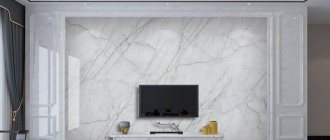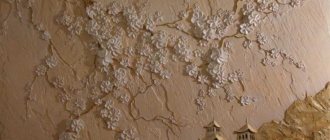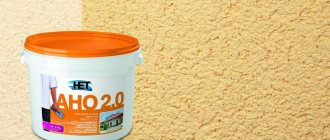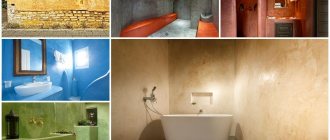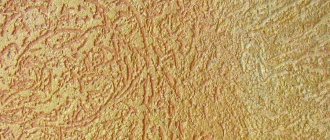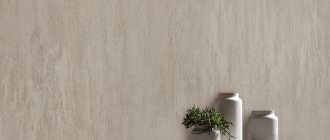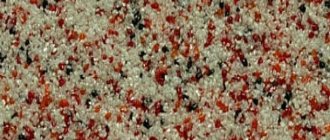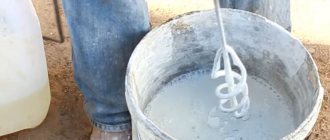Your bath requires sophisticated decor - try Venetian plaster. It is made from marble dust, onyx, granite or other expensive types of stones. In accordance with accepted technologies, builders add natural pigments and slaked lime to the mass. The current option involves the use of piece dyes together with acrylic adhesives. Venetian plaster in the bathroom transforms the room in every way. Marble dust creates shimmer and deep light. Polymer components prevent cracking and extend the service life of this type of decor.
Modern technologies answer the question: is it possible to do a Venetian in the bathroom? An innovation is considered to be silicone Venetian plaster, made specifically for damp environments. The mixture is not afraid of dampness and temperature changes.
Shower sections and vertical structures close to the bathtub should not be covered in this way. Plaster is not friendly with water. For these places, transparent glass and sealant at the joints are used.
Once Venetian plaster is installed, the finished top coat will prevent bacteria from growing in a damp room. This finish in the bathroom does not emit harmful substances and is considered environmentally friendly.
Features of bathroom finishing
When renovating rooms with high humidity, preference is given to mixtures with moisture-repellent components. To ensure that the walls last a long time, choose a moisture-resistant material.
Before starting work, surfaces are thoroughly cleaned. Defects are eliminated, cracks are sealed, covered with deep penetration soil, then proceed to plastering the surface.
Venetian is used to finish all surfaces in the bathroom. The walls and floor are covered with the solution. It creates a ceiling that will add sophistication to the room.
Venetian plaster in the bathroom will add sophistication and individual style to the room
How to apply decorative plaster correctly
The quality of decorative plaster in the bathroom directly depends on the exact implementation of the instructions for the materials and the correct preparation of the base.
Pay attention to the following nuances:
- temperature regime – the minimum temperature for plastering is +5°C, the maximum is + 35°C;
- humidity – up to 60%;
- absence of drafts;
- all wiring is de-energized.
Ready-made solutions have a shelf life (time from mixing to the start of setting). To avoid wastage of material, mix as much solution as is necessary for full use during this period.
Preparation
Before plastering, the base is thoroughly cleaned and prepared for applying the plaster layer.
Preparation is carried out in stages:
- In the room being renovated, old coatings that do not meet the requirements for adhesion strength to the applied solutions (paint, whitewash, peeling plaster finish) are removed.
- In a new building, brick walls are cleaned with metal brushes (scratched bricks adhere more firmly to the mortar), and the seams are cleared to a depth of 10 mm. Concrete walls are covered with notches.
- Remove dust from the surface with a vacuum cleaner, brush or damp cloth.
- Foci of fungus and mold growths are scraped off, then treated with disinfectants.
- Stains from fats, oils, grease, and rust are treated with special solutions until completely cleaned. Where this is not possible, the oiled top layer of the wall material is cut down. Remove efflorescence.
- Pull out and remove excess metal parts (old fasteners, nails). The remaining metal parts are coated with oil paint or other insulating compounds.
- Lumps and protrusions are chipped away. Holes and cracks are filled with cement-based mortar. If necessary (large cracks, brittle surfaces of the wall material), reinforcing mesh is applied to strengthen the area.
- Cover with a primer (deep penetration type) twice with intermediate drying.
- If necessary, apply a waterproofing layer.
- Putty on the dried primed surface. If leveling plastering work was previously carried out, only a primer is applied under compositions with a different base.
Cleaning the wall from old coating
Removing dust from a wall with a mop
Removing streaks on the wall
Repairing a crack on the wall
Applying primer
Puttying the wall
Application
Depending on the final decorative effect, textured plaster in the bathroom is applied in one or several stages. For example, for Venetian, travertine, and a number of other types of finishes, the base layer is made with a thickness approximately equal to the size of the filler fraction. To apply a pattern using figured rollers, one layer is applied, but thicker.
There are several methods for transferring the solution to the base:
- spraying (throwing with a ladle or trowel);
- spreading (with a spatula or trowel), several ways;
- trimming (“pecking movements of the end of the hand);
- sticking by hand (for example, clay mixture);
- rolling with a roller (similar to applying paint).
Methods for forming relief:
- imprint – performed by rolling a figured roller, stamps or matrix;
- pressing by trimming using a tool (trowel, end of a brush) or auxiliary means (grids, crumpled bags, whatever is at hand);
- making furrows by holding the tool in linear or circular movements (notched trowel, comb, stiff brush);
- gluing with lifting of the top layer to the tool and partial displacement of the raised mass (Versailles finish);
- the use of various smear techniques;
- use of stencils;
- cutting or incised patterns (sgraffito, masonry seams);
- a special kind of rolling of large filler grains (bark beetle).
It is possible to combine several methods to create a unique bathroom design.
Subsequent operations usually include smoothing protruding parts and grinding the surface. For the Venetian, iron ironing is used. You can read more about techniques for creating decorative effects in the relevant articles on the site.
Additional videos on using decorative brick-like plaster and plain paper plaster in the bathroom.
Final finishing stage
Although the decorative plasters used are moisture-resistant, they are coated with varnishes or paints that form a waterproof film. For decorating wet sanitary areas, waterproof paints based on silicone or acrylic resins are most suitable. Paints and varnishes are applied only after the decorative plaster layer has dried. There are several techniques for applying paint (in one or two multi-colored layers).
Varieties of Venetian plaster
According to technical characteristics, purpose and external parameters, Venetian plaster is divided into types:
- Smooth. The base is light-colored lime. The finished coating is smooth and even. Requires application skills.
- Embossed. It has a heterogeneous structure. The relief of the coating is achieved by containing marble lumps in the composition, creating depressions and grooves on the wall.
- Artistic. Creates a complete image or drawing.
Smooth Venetian plaster
Relief Venetian plaster
Artistic Venetian plaster
Depending on the specifics of installation, decorative plaster for the bathroom is divided into:
- classical;
- marble;
- textured;
- mother-of-pearl;
- Venetian with marble chips.
Moisture-resistant decorative plasters - manufacturers and features
The choice of offers of moisture-resistant decorative plasters for the bathroom is large. This is difficult at first. Beginners are often guided by brand names. Popular manufacturers create lines of plaster for wet rooms. Branded formulations differ in quality.
Among mineral materials, the moisture-resistant gypsum textured composition Rotband from the Grundband company is popular. It has high plasticity, increased adhesion, a layer thickness of up to 5 cm, and accelerated strength development. Suitable as decorative plaster in the toilet.
The decorative acrylic composition kratzputz D227 from Dufa (giving an orange peel effect) deserves praise. High-strength, vapor-permeable material with increased adhesion.
Stuc granito and deco are innovative microcement material (cement-polymer) from Marcel. Moisture resistant when the thickness reaches 3 mm or more (2 – 3 layers).
The Russian silk mixture “Rodnik-Art”, the Turkish one “Silcoat” contains artificial silk fibers as a filler.
Not only plasterers can perform decorative plaster for the bathroom. Many types of effects are feasible for beginners who are picking up a spatula for the first time. It will not be superfluous to perform preliminary practice on fiberboard sheets or on the walls of the utility room.
Of course, there are techniques that are particularly difficult to perform, such as Venetian marble plaster. But it can also be mastered if you have patience and the desire to achieve the goal. In order not to ruin expensive ready-made compositions, such as silk, Venetian, Moroccan mixtures, you can train on putties or fine-grained acrylic compositions. The putties used for training are much cheaper.
Features of color and design
Venetian differs not only in composition and performance characteristics, but also in color scheme, installation technology and design. The decoration includes materials with golden, silver or mother-of-pearl shades. A little less often - walls made of malachite, jasper, granite.
Based on appearance, there are 4 types of decorative plaster:
- Veneto;
- Trevignano;
- Marbella;
- Encausto.
Materials have become widespread in design.
Veneto
Veneto is a type of decorative plaster that looks like marble. A distinctive feature is the smooth surface. Requires sanding during application. After drying, it creates a reliable, durable surface that is easy to clean. The layer can only be washed with a damp sponge; neither a brush nor chemical cleaning agents are suitable.
Veneto is a classic semi-matte lime plaster
Trevignano
Trevignano is a material that allows you to obtain a mirror finish. A distinctive feature is the internal lighting.
The result of high-quality work is imitation marble with a mirror finish. Each layer appears translucent, with splashes of color. Thanks to this, Trevignano creates an unusual effect.
Trevignano is a luxury Venetian plaster with a mirror reflection
Marbella
Marbella is a decorative material that creates an imitation of roughly processed stone. It is used in the design of hallways, staircases, common rooms, and less often bathrooms.
Marbella is a Venetian plaster with the effect of rough-cut marble
Encausto
Encausto is a mass that creates a granite finish. The base is dominated by gray, greenish or gray-green shades.
Encausto - Venetian plaster, with the effect of semi-matte marble with terracotta splashes
Varieties
The plaster mixture varies depending on the base, fillers and texture.
Sanitizing
It has a porous composition, due to which moisture is retained. Serves for application under a decorative layer.
Type of sanitizing plaster.
Mineral
Consists of natural components: lime, cement, marble and granite chips. It is purchased in powder form and requires dilution with water. Possessing high vapor permeability and moisture resistance protects against the formation of fungi and damage. The plastered surface can be washed using household chemicals, brushes and sponges of different abrasive textures.
Mineral plaster for walls.
Important! To maintain plasticity, a solution is prepared before use. Not recommended for use in areas subject to vibration.
Acrylic
This facade plaster is based on synthetic resins with the addition of crushed glass. It has strength, elasticity and crack resistance. Due to the composition, a textured design is used, using different colors and richness. It goes on sale in the form of an aqueous solution. When applied, it dries quickly and hardens.
Acrylic type of plaster.
Note! This type of finishing has low air exchange and is suitable for rooms with good ventilation.
Silicone
This decorative plaster in the bathroom is filled with silicone resins. It is suitable for leveling and decorating walls. Silicone and special components included in the product serve as reliable protection against mold, dampness, and prevent the appearance of harmful microorganisms. The mixture is characterized by good vapor permeability, plasticity, ease of application, and resistance to ultraviolet radiation.
Silicone plaster in the bathroom.
Additional Information! The best plaster option for a bathtub is a silicone-based solution. It has dust-repellent properties that promote durability.
Silicate
This mixture is prepared on the basis of liquid glass. It promotes oxygen exchange and does not allow water to pass through. The color range of the products allows you to give the bathroom a special look.
Silicate plaster in the bathroom.
Important! May have toxic properties.
Plaster
This material contains gypsum and polymer additives. Due to its elasticity in its raw form, it allows you to create a patterned structure.
Attention! Use with caution; the plaster is suitable for well-ventilated rooms. Due to its hygroscopicity, it cannot be used in small baths where a lot of steam is generated.
Gypsum plaster.
Venetian
A coating used when decorating interiors in a classic or antique style. The plaster mass is made from slaked lime, which serves for viscosity. Marble dust is added to it, resulting in the creation of a marble pattern. To give a glossy effect, the surface is rubbed with wax. The desired color is achieved by adding acrylic pigments.
Venetian plaster walls in the bathroom.
Additional Information! The mixture is suitable for families with small children; its smooth texture will prevent unexpected injuries.
Decorative marble finishing requires high-quality preparation of the walls, removal of all flaws, crooked corners and humps, and application of a primer. When decorating with Venetian plaster, artistic painting, texture in the form of natural stone, and various color options are applied. The pattern depends on the size of the particles filling the solution and the stencil used.
Decorating walls with marble effect using plaster.
The most suitable types for the bathroom are: silicone, sanitizing and Venetian plasters.
Additional Information! After drying, the plane becomes more expressive than when applied.
Which Venetian to choose for the bathroom
The choice of Venetian plaster is a matter of individual preference. Color, texture, and the desired effect directly depend on the overall design concept of the room.
When choosing, experts recommend adhering to a number of rules:
- Color. The color scheme is selected depending on the shade of decorative elements and the furnishings of the room. The most popular are pearl-matte shades. Mother-of-pearl shine will create an interesting refraction of light in the bathroom. The presence of beige in combination with gray will make the interior warmer.
- Compound. Classic products contain lime. Its presence increases the plasticity of the material, but reduces its water-repellent properties.
- Texture. The grain size of the inclusions is chosen based on the design features.
- Moisture-repellent properties. Preference is given to mixtures with moisture-repellent components.
Venetian plaster should be selected based on the material of the surface being treated and many other factors.
Choosing the right texture for the bathroom
The classic structural plaster is “bark beetle”. There are other options, but they are not as popular. However, even if the material you choose is suitable for a bath, we still do not recommend using it if we are talking about bark beetle. Decorative plaster on the walls in the bathroom will not protect you from the hassle of cleaning them in the future. A month, a year or five years will pass, but the issue of dirty walls will come up. The walls in the bathroom become dirty due to natural reasons and will have to be washed. Plaque due to contact with water will cause particular problems.
If you have washed tiles, then you know how good it is when the surface is smooth. But with the “bark beetle” structure and others like it, there is no need to talk about simplicity. Of course, the protruding layer will be washed, but all the depressions will remain dirty, and the wall will change its color. It’s another matter if after applying decorative plaster you get a smooth wall. This surface is easier to clean, which is also important when choosing decorative plaster for the bathroom. Of course, it’s up to everyone, but it doesn’t hurt to know all the pros and cons.
Another important advantage of the smooth surface is the ability to use a variety of suction cups for fastening. Of course, you can hang hooks and soap dishes on dowels, but with suction cups it’s somehow aesthetically pleasing. You will not be able to attach them to a rough surface. If you have a child, you can periodically cover the walls with decorative stickers, which are easily removed and do not leave marks on the surface.
Advantages and disadvantages
Venetian rightfully takes its place among finishing materials and is actively used for decorating bathrooms due to a number of advantages:
- High aesthetic performance. The surface has a rich color palette and a beautiful relief.
- Vapor permeability. The coating breathes, thanks to which the glass in the room does not fog up and condensation does not form. The room provides the most comfortable microclimate.
- Easy to maintain. The material is easy to clean and resistant to fungus and mold.
- Finishing speed. If you have experience, it can be quickly applied and leveled. The work takes on average from 3 to 7 days.
- Maintainability. The base does not require perfect alignment. The presence of defects is hidden by the author's design; existing defects can be easily repaired without covering the entire layer of plaster.
The main advantage of Venetian plaster is the speed of application of the finishing material
Compared to the use of tiles, Venetian plaster is a more affordable material.
The Venetian has repeatedly shown excellent results when decorating bathrooms. But the mixture also has a number of disadvantages:
- Peeling and cracking. If installation is carried out in violation of the temperature regime or technology, cracks may occur or peeling off from the base surface.
- Durability. The original shine of the Venetian is given by a thin layer of wax, which is used for finishing application. Under the influence of chemicals for cleaning the room, this layer is quickly erased, which leads to a decrease in the performance characteristics of the material and a decrease in the durability of the coating.
- Labor intensity. To obtain a high-quality decorative surface, experience with the solution is required.
Venetian plaster is prone to developing defects some time after its use.
Application technology
The finishing of the walls in the bathroom is carried out in two stages. The first is preparing the necessary tools, materials and surface. The second is laying decorative coverings.
Preparatory work
The preparatory stage is an important part of the finishing work. It consists of choosing a mixture, purchasing the necessary tools, and cleaning the walls.
To work you will need:
- steel spatulas;
- deep penetration soil;
- solution;
- wax;
- roller;
- brushes;
- container for soil;
- solution container;
- construction mixer.
Necessary tools for applying Venetian plaster
The solution should only be applied to prepared walls. To do this, they are cleaned of contaminants, existing defects, dowels, nails, and fittings are removed. The surface is dried and treated with primer. The primer is applied in 2 layers with an interval of 12–24 hours. After this they move on to finishing.
Application process
The process of applying Venetian plaster includes several stages:
| 1.Preparation of the solution. The dry mixture is applied according to the instructions indicated on the package. It is important to observe the proportions and mixing time. | |
| 2. First layer. The mixture is thrown onto the walls and leveled with a spatula. The base coat is made thin. The thickness does not exceed 1–2 millimeters. | |
| 3.Second layer. The thickness of the second layer also does not exceed 1–2 millimeters. A spatula is used for application. | |
| 4. Third layer. For the finishing coat, a waterproof mixture is used. The solution is poured over with a spatula and leveled to a perfectly smooth state. | |
| 5.Grinding. If the application technique involves creating a glossy effect, then after the solution has dried, the walls are carefully sanded. |
Experts recommend applying at least 3 layers of Venetian plaster. The more approaches, the more interesting the result. To improve the decorative qualities and durability of the material, 5–7 days after application, grout with wax.
Application method
The Venetian in the bathroom is laid in several layers to guarantee a bright pattern, similar to a stone wall. The smallest number of layers is three, but professionals use more with a beautiful painting in the end. Place the first ball using short circular movements using a spatula with right angles.
Try to make a layer 1 millimeter thick, which will completely cover the walls and ceiling. Then the ball dries for two to three hours. The dried top is sanded with a metal spatula or fine sandpaper.
Apply the next ball with asymmetrical, choppy strokes and rub it into the corner with a spatula adapted for such work. We remove excess material. We try to press the upper ball into the lower one. Make clear movements and get veining with the visual effect of marble material. This technique is called “butterfly”.
The mixture dries quickly, you need to apply it in small areas. Approximately an hour is needed per square meter. Deep drawing is achieved by a large number of layers. Only professionals in their field can create a unique design.
Regardless of the amount of plaster, it is eventually necessary to apply wax to the surface. This material will add shine, gloss and internal light, protect the plaster from dampness and mechanical damage. We use wax no earlier than 7 days after laying the last ball. The thickness of the wax coating should be thin to avoid the appearance of dark spots.
Features of care
The Venetian is easy to care for. To preserve the decorative and operational properties of the coating, a number of rules must be followed:
- The material reaches performance characteristics only 4–5 weeks after application. Before this period, it dries out and requires careful handling. The surface is sensitive to mechanical damage and moisture.
- The room in which this type of finishing is used must be equipped with forced ventilation. This ensures an extended service life of the material.
- To clean the walls from dirt, use a damp cloth or sponge. It is allowed to use products without abrasive components. The use of hard sponges, brushes, and caustic substances is unacceptable.
- Petroleum products or solvents are not allowed to come into contact with the surface.
- If chips, cracks or other mechanical damage appear, the finish can be repaired using a new portion of the solution.
- To extend its performance properties, it is necessary to restore the wax layer every 4–5 years.
Venetian plaster can be wiped with a damp sponge
Following the rules for caring for Venetian plaster will preserve its decorative properties for a long time.
Modern manufacturers
The list of modern manufacturers producing Venetian plaster includes more than a dozen companies. Their area of activity also includes the production and sale of other types of finishing materials:
| 1.Ruston. The main direction is the production of compositions with metal inclusions. Most suitable for high-tech areas. | |
| 2.Wall2Flor Top Coat ¬– used to create a design in a minimalist style. Creates a seamless concrete surface. | |
| 3.Klondike. The composition contains gold and silver inclusions. The solution allows you to create an expensive luxury finish. | |
| 4.Sambulador. Italian brand of plaster with the addition of shiny sand. The finished surface has a pearlescent sheen. The color range ranges from burgundy to heavenly. | |
| 5.Cebo Glam. Manufacturer of luxury finishing materials. The plaster is available in pastel colors. Beige, blue, and purple shades predominate. |
Novacolor deserves special attention. It supplies the market with several types of mixtures:
| 1.Dune. With a soft pearlescent sheen. | |
| 2. Mirror. Lime mixture with minerals and inorganic pigments. Used for finishing indoors and outdoors. Polishes well. | |
| 3. Magnat Venetian Stucco. The solution is suitable for the design of bathrooms, swimming pools, steam rooms. The finished coating resembles marble. | |
| 4. Rockcote. A distinctive feature is the creation of a mirror marble surface. | |
| 5. Feidal Venedigputz. Acrylic mixture with a high degree of adhesion. Allows you to create a finishing layer with a glossy and mirror-like shine. |
Recommendations for selection
When choosing facade plaster, you need to make sure that the material has environmental properties and that there are no chemical compounds that can cause harm during operation.
When decorating walls, special attention should be paid to the harmlessness of the material.
All materials for bathroom renovations must be moisture resistant. This condition will help avoid the following negative consequences:
- peeling;
- black spots;
- bubbles.
The type of finishing material affects the duration of the work. If there are no time restrictions, you can use cement-based plaster.
All materials for finishing the bathroom must have high moisture resistance.
Gypsum mixtures are available in well-ventilated areas. In the future, they can be tiled or decorated.
For speedy design, it is better to select acrylic compositions that dry quickly. Rough terrain with grooves requires the use of a composition with hard granules. A uniform roughness can be achieved using a soft sponge.
For decoration, use a plastic spatula, roller or sponge.
After covering with the finishing layer, use of the bathroom is prohibited for 2-3 days.
Finishing materials are durable, so it is necessary to take into account possible changes in the interior associated with updating plumbing and adding missing elements in the future.
Options for using Venetian plaster in the bathroom
Venetian is used to renovate living rooms, corridors, and halls.
However, it has the greatest success in finishing bathrooms. Thanks to the natural ingredients, the mixture does not have a pungent odor. Venetian is an environmentally friendly material. Thanks to polymers, the solution does not crack the finished coating and withstands moisture well. Note! With proper care, Venetian plaster coating lasts up to 10 years.
If the installation technology is followed and protective wax is used, the coating is impervious to mold and mildew. Defects that often appear in bathrooms can be easily restored without changing the layer.
Thanks to its decorative qualities and performance characteristics, Venetian is widely used for finishing bathrooms.
Venetian plaster in the bathroom has become widespread due to its water-repellent properties.
Why Venetian plaster is rare in the interior
Despite its high performance characteristics and excellent decorative qualities, the Venetian is a rarity in the interior. It is used to create luxury, expensive design in country houses or spacious apartments.
The reason is the complexity of the work and the demands on the skills of a specialist. Venetian is considered a capricious type of plaster. It requires surface preparation and the use of deep penetration soil.
Applying Venetian plaster is a complex process that requires special knowledge
Among the requirements for the base coating are the absence of dirt, defects, curvature, and dust. Walls should absorb moisture as little as possible. Often, specialists carry out additional reinforcement and treatment with putty before applying the Venetian.
Another reason for rare use is the need to apply multiple layers. They are made from 3 to 10. Each is unique in texture and color. The more layers are used, the more interesting the finished coating turns out.
Practical tips and advice
Thanks to the advice and recommendations of specialists, it is possible to obtain a high-quality and durable coating, as well as minimize labor costs for applying the material:
- Gypsum compounds are not used for bathrooms, even if they indicate that they have moisture-resistant characteristics.
- Do not use cement mixtures that contain lime. It increases plasticity, but reduces water-repellent properties.
- A suitable mortar for the bathroom is cement mortar with moisture-repellent characteristics.
- They don't skimp on the manufacturer. Low cost does not guarantee high quality solution.
- For finishing work, only fresh compounds are used. The production date and service life affect the quality of work.
- The choice of material is made based on the type of walls in the bathroom. A mixture with coarse sand is suitable for finishing brick surfaces, and fine sand for concrete blocks.
- Tools are thoroughly cleaned. During a long break, the spatulas are washed and dried.
- During the finishing period, the surface is protected from dirt and dust.
For the bathroom use a cement moisture-repellent composition
The decorative properties of the Venetian completely depend on the creative approach and vision of the performer.
Venetian plaster is an expensive finishing material. It creates a unique bathroom design. Thanks to polymer components and protective resins, the finished coating is reliable and has a long service life.
Have you already used Venetian plaster for finishing? Tell us about your experience!
What types of decorative plaster can be used
Manufacturers produce various types of decorative plaster, which differ in characteristics, quality and the main component included in the composition. There are several types of plaster coating that can be used to carry out repairs and finishing in the toilet room.
Silicate plaster
Repairing and finishing a toilet with decorative plaster can be done using silicate mixtures.
Silicate materials give the coating high strength and increase its wear resistance. High-quality mixtures can last up to 60 years.
In addition, the silicates included in the solution have moisture resistance and good vapor permeability. All this allows you to create comfortable conditions in the bathroom, as well as give the toilet a beautiful appearance.
Mineral plaster
This version of the mixture has good moisture resistance, it is permeable to steam and air, and also prevents the spread of fungal colonies. All this allows you to place mineral coatings not only in the toilet, but also in bathrooms combined with a bathtub.
Acrylic plaster
The service life of acrylic options can be up to 50 years. Finishing the toilet with decorative acrylic plaster allows you to create a suitable design, as well as ensure moisture resistance and vapor permeability of the walls. The presented option has good plasticity, so it is easy to apply to any surface.


